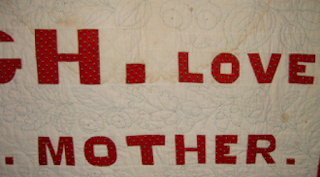 UILT" is a general term for a multi-layered blanket held together with stitching; it has come to designate the kind with a top layer made of sewn-together pieces. This folk craft has evolved into an art form that makes images, patterns, and words out of small bits of cloth.
UILT" is a general term for a multi-layered blanket held together with stitching; it has come to designate the kind with a top layer made of sewn-together pieces. This folk craft has evolved into an art form that makes images, patterns, and words out of small bits of cloth. American quilts celebrate the resourcefulness of frontier women coping with isolation and making do with very scarce resources. Innovating on their own, they created new traditions in their patterns and designs. Especially after 1800, when fabric dyes became more permanent, they invested many hours in transforming the scraps of material left over from family dressmaking into beautiful blankets and covers. Men's shirts, less tailored to the body, could be cut from white cotton without wasting material, but even when pattern pieces for women's fitted dresses were tightly spaced, they left patches of unused fabric. These strips, squares, and irregular triangles or hexagons became the raw ingredients of a pieced quilt. American quilters created an infinite variety of patterns: "Log Cabin" from strips; nine-piece and all-over grids of squares; starbursts from long pointed scraps: and virtuoso renderings from triangles and hexagons.
The attitude of the local community was a key element in elevating this folk craft into art; people valued thrift, industriousness, and making do on very little. Women who worked with their hands were admired, not stigmatized, and a life of leisure was not an American goal. Innovation was welcomed and shared, not feared.
Early in the 20th century the craft and art of quilting became popular in England, where, separated from its roots in pioneer thrift, it nevertheless appealed to women for its artistic expressiveness. By 1930 the craft was so highly developed that American women could trade their quilts for merchandise, collaborate on them for local occasions, and exhibit them to spread designs and ideas. By 1950 American curators and collectors had begun to seek out and preserve quilts, both for their designs and for their cultural insight.
 |
| Alphabet quilts could follow the same grid as needlepoint letters. |
Incidentally, quilts were pieced from new scraps, not old rags. Too much work went into them to risk having them wear out right away. All the pieces in a quilt must be new, and of similar weight, to avoid weak spots that would pull apart in the wash or during use. Rags were used in braided rugs.



What do you make of the reversed N in the Lord's Prayer? Was that a common letter variation at the time?
ReplyDeleteI don't know, and I've posted a general inquiry too.
DeleteI can't come up with any reason! Sometimes people who use a pattern reverse it by accident and then don't notice until the design is done. [I've done this in my past...I once carved a whole wood block for a print wrong in an all-nighter.] Anyone else have insights?
ReplyDelete